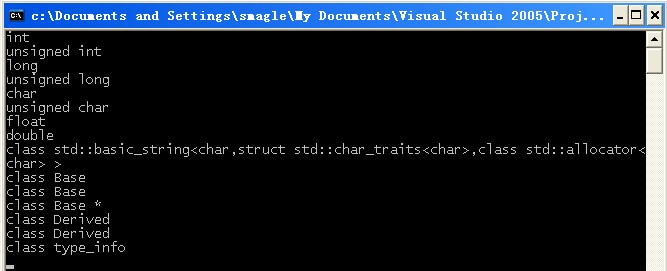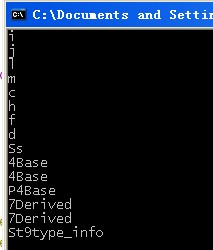1.RTTI
1)运行时类型识别RTTI(Run-Time Type Identification),它能够获取基类指针或引用所指向的对象的实际类型,在C++中,为了支持RTTI提供了两个运算符:typeid和dynamic_cast
2)当某种情况下无法使用虚函数时,却要完成类似于虚函数的功能时,可以使用RTTI,后面将会举例讲解这种情况
2.dynamic_cast
2.1概念
1)dynamic_cast运算符用于将基类的指针或引用安全地转换成派生类的指针或引用,这是安全的“向下转型”,至于“向上转型”,即派生类指针或引用转换为其基类指针或引用,本身就是安全的,尽管可以使用dynamic_cast进行转换,但这是没必要的, 普通的转换已经可以达到目的,毕竟使用dynamic_cast是有开销的
2)dynamic_cast使用形式:dynamic_cast<type*>(expression)
dynamic_cast<type&>(expression)
dynamic_cast<type&&>(expression) //右值引用
其中type必须是一个类类型,并且通常具有虚函数,否则编译会报错
3)当 expression 是基类指针或引用时:
- 如果此基类指针或引用所指向对象是派生类类型的,这种转换是安全的,可以成功
- 如果基类指针或引用所指向对象为基类类型,这种转化是不安全的,会失败
4)对于指针,转换失败了,则返回结果0,即返回的指针为NULL,不会抛出bad_cast异常
5)对于引用,转换失败了,则会抛出bad_cast异常
class Base { public: Base() {}; virtual void Show() { cout << "This is Base calss"; } }; class Derived :public Base { public: Derived() {}; void Show() { cout << "This is Derived class"; } }; int main() { //第一种情况,转换成功 Derived d; Base& base1 =d; Derived& der1 = dynamic_cast<Derived&>(base1); cout << "第一种情况:"; der1.Show(); cout << endl; //第二种情况 Base b; Base &base2 = b; cout << "第二种情况:"; try { Derived& der2 = dynamic_cast<Derived&>(base2); } catch (bad_cast) { cout << "转化失败,抛出bad_cast异常" << endl; } return 0; }
3.typeid
3.1概念
1)typeid运算符用于返回表达式的类型
2)typeid使用形式:typeid(expression);
如果表达式的类型是类且至少包含有一个虚函数,则typeid返回表达式的动态类型,需要在运行时计算;否则,typeid操作符返回表达式的静态类型,在编译时就可以计算
3)typeid运算符的返回值是type_info类的引用,ype_info类在头文件typeinfo中定义
4)type_info类提供了public虚析构函数,以使用户能够用其作为基类。它的默认构造函数和拷贝构造函数及赋值操作符都定义为private,所以不能定义或复制type_info类的对象,程序中创建type_info对象的唯一方法是使用typeid运算符

3.2实例
class Base {}; class Derived: public Base {}; int main() { Base b, *pb; pb = NULL; Derived d; cout << typeid(int).name() << endl << typeid(unsigned).name() << endl << typeid(long).name() << endl << typeid(unsigned long).name() << endl << typeid(char).name() << endl << typeid(unsigned char).name() << endl << typeid(float).name() << endl << typeid(double).name() << endl << typeid(string).name() << endl << typeid(Base).name() << endl << typeid(b).name()<<endl << typeid(pb).name()<<endl << typeid(Derived).name() << endl << typeid(d).name()<<endl << typeid(type_info).name() << endl; return 0; }
VS和GCC的结果:


class Base {}; class Derived : public Base {}; int main() { Base b, *pb; pb = NULL; Derived d; Base* pb2 = new Derived;//向上转型是安全的 Base& b2 = d; Base* pb3 = &d; cout << typeid(pb2).name() << endl//输出Base * << typeid(b2).name() << endl //输出Base,b2是一个类的引用,但这个类没有虚函数 << typeid(pb3).name() << endl//输出Base *,pb3是一个指针 << typeid(*pb3).name() << endl;//输出Base,*pb3是一个类,但这个类没有虚函数 return 0; }
现在对Base加上一个虚函数:
class Base { public: virtual void f() {} }; class Derived : public Base {}; int main() { Base b, *pb; pb = NULL; Derived d; Base* pb2 = new Derived;//向上转型是安全的 Base& b2 = d; Base* pb3 = &d; cout << typeid(pb2).name() << endl//输出Base *,pb2是一个指针,不是类对象 << typeid(b2).name() << endl //输出Derived,b2是一个基类的引用,这个类有虚函数,返回动态类型 << typeid(pb3).name() << endl//输出Base *,pb3是一个指针,不是类对象 << typeid(*pb3).name() << endl;//输出Derived,*pb3是一个类对象,这个类有虚函数,返回动态类型 return 0; }
4.使用RTTI
4.1实例
为具有继承关系的类实现相等运算符
4.2分析
1)对于两个对象来书,如果它们的类型相同并且对应的数据成员取值相同,则视为相等
2)对具有继承体系的类实现“==”,必须考虑比较对象在体系中所处的位置,因为派生类相对于基类有着自己的新成员
3)一种容易想到的解决方案是定义一套虚函数,令其在各个层次上分别执行相等性判断;遗憾的是,这个方案其实不能凑效,因为虚函数的基类版本和派生类版本的形参必须完全相同,如果定义一个虚函数equal,则它的形参必须是基类的引用,此时,equal函数就只能比较基类的成员,而不能比较派生类的成员
4)使用RTTI解决问题:
- 相等运算符的形参是基类的引用,使用typeid检查两个对象的类型是否一致
- 若不一致,直接返回false;若一致,则调用虚函数equal继续判断,在虚函数的派生类版本中调用dynamic_cast将基类的引用转换为派生类的引用,这样才能比较派生类的成员
class Base { friend bool operator==(const Base&, const Base&);//相等运算符为Base的友元 public: // Base其他成员 protected: virtual bool equal(const Base&) const;//虚函数equal }; class Derived : public Base { public: // Derived的其他成员 protected: bool equal(const Base&) const; }; bool operator==(const Base &lhs, const Base &rhs)//作为Base的友元,可以使用Base的非public成员 { //当运算对象类型相同时才调用虚函数equal return typeid(lhs) == typeid(rhs) && lhs.equal(rhs);//运算对象均为Base对象时,调用Base::equal;运算对象均为Derived对象时,调用Derived::equal } bool Derived::equal(const Base &rhs) const { // 基类引用绑定在派生类对象上,这个转换是成功的;同时这个转换必不可少,因为*this是Derived对象,形参是Base对象,执行了转换后,才能访问形参对象的派生类成员 const Derived& r = dynamic_cast<const Derived&>(rhs); // 比较两个Derived对象是否相等 …… } bool Base::equal(const Base &rhs) const { // 无需先转换形参,因为*this和形参都是Base对象 // 比较Base对象 }